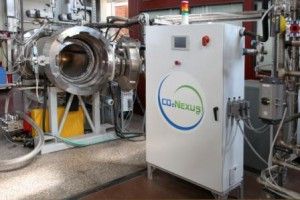State funds dry cleaners’ shift to CO2
by Wayne Lusvardi | July 30, 2014 11:41 am
 The California Energy Commission’s[1] Public Interest Energy Research Program has produced a dry cleaning machine that uses CO2. The carbon-based cleaning process replaces perchoroethylene chemical-based dry cleaning.
The California Energy Commission’s[1] Public Interest Energy Research Program has produced a dry cleaning machine that uses CO2. The carbon-based cleaning process replaces perchoroethylene chemical-based dry cleaning.
The machine is being tested by the Aramark uniform cleaning corporation in Los Angeles. Colorado-based firm C02Nexus received a $396,200 CEC grant[2] on Dec. 3, 2009 to develop an alternative dry cleaning machine using C02.
Carbon dioxide (CO2) is a greenhouse gas[3] whose reduction is the target of Assembly Bill 32, the Global Warming Solutions Act of 2006 — although the phrase “climate change” usually is used today. But according to CO2Nexus[4], “The CO2 used in the CO2Nexus systems is recycled from existing industrial processes and as such is completely carbon neutral.”
So the problem with the subsidies is not the CO2, but the use of public funds.
CO2Nexus is a business spinoff from FeyeCon Development and Implementation B.V.[5], which is based in the Netherlands[6].
Redundant technology
The CO2Nexus technology was redundant to private industry research and development already in operation in the United States in June 2008[7] by the Solvair Corporation[8], based in Evanston, Ill. The Solvair system was installed by several private dry cleaners in the Midwestern and Eastern U.S. in 2008[9] and 2009[10]. Nu-Yale Cleaners[11] in Louisville, Ky., received a grant from the Indiana Department of Environmental Management to install the Solvair system on Nov. 25, 2008. By October 2010, the U.S. Air Force[12] had already started ordering the Solvair carbon-based dry cleaning system. Moreover, the Kreussler Corporation[13] in Europe introduced its SYSTEMK4 dry cleaning machine in the U.S. in 2009. The SYSTEMK4 dry cleaning chemical has no carbon footprint[14] and is already being used in Fresno, California.
Carbon cleaning replaces “perc” dry cleaning
In 2007, the California Air Resources Board[15] issued a regulation to phase out all use of perchoroethylene used in dry cleaning as a toxic air contaminant under California’s Toxic Air Contaminant Identification and Control Program (Health and Safety Code section 39650, et. seq.). Perc[16] has been attributed to contaminating 5 percent of all water wells in the state and is considered a toxic industrial chemical. With the phase out of perc, there was a need to find other solvents and technologies that would be safe for groundwater, dry cleaning workers and air emissions.
Exempt from cap-and-trade emissions regulations?
Under the authority of AB32, CARB has instituted its cap-and-trade program[17] to reduce carbon emissions. Large industries and utilities that emit CO2 above designated levels (called a “cap”) must buy pollution permits (called “trade”) from CARB. If they don’t buy a pollution permit, they must reduce their emissions.
Only large industries and utilities are subject to cap and trade today. Fuel suppliers will be subjected to it next year[18].
Small businesses are not subject to cap-and-trade emissions regulations today, so the CO2 reductions at a dry cleaner are not mandated, but still fit in with AB32’s overall goal. Local businesses, however, are subject to regulation of toxic emissions and industrial hazards.
Controversial PIER energy research grant
The Public Interest Energy Research Program has spent $700 million of California utility ratepayers’ money from 2000 to 2011 by tacking a “fee” on all utility bills, including $44.5 million[19] in funding in 2013. The program is controversial, as the impartial California Legislative Analyst’s Office[20] concluded there never has been any “clear payoff” for ratepayers from its research.
On Dec. 12, 2013, an LAO report “Energy Efficiency and Alternative Energy Programs”[21] concluded that California’s $15 billion in scattered energy programs were duplicative, not aligned with legislative priorities, and ineffective.
The funding of redundant dry cleaning machinery to compete with U.S. based companies that had already installed similar machinery in 2008 is sure to make the PIER program even more controversial.
- California Energy Commission’s: http://www.imperialvalleynews.com/index.php/news/california-news/10058-world-s-first-ever-water-free-laundry.html
- $396,200 CEC grant: http://www.energy.ca.gov/business_meetings/2010_packets/2010-08-25/2010-08-25_Item_10_CO2Nexus/2010-08-25_Item_10_DM.pdf
- is a greenhouse gas: http://www.arb.ca.gov/cc/inventory/inventory.htm
- according to CO2Nexus: http://calwatchdog.com/?p=66334&preview=true
- FeyeCon Development and Implementation B.V.: http://asmewelding.wordpress.com/2011/07/22/precision-helps-co2-nexus-launch-new-technology/
- Netherlands: http://webpagesinfo.com/www/feyecon.com/
- June 2008: http://www.csrwire.com/press_releases/14727-Green-Apple-Cleaners-Expands-Reach-to-Health-Conscious-Customers
- by the Solvair Corporation: http://www.nbcchicago.com/news/green/Evanston_First_To_Offer_Environmentally_Safe_Dry-Cleaning.html
- 2008: http://www.bizjournals.com/louisville/stories/2008/11/17/story8.html
- 2009: http://www.prweb.com/releases/2009/11/prweb3155554.htm
- Nu-Yale Cleaners: http://www.state.in.us/portal/news_events/29352.htm
- U.S. Air Force: http://solvaircleaning.com/Kadena%20Adds%20Second%20Solvair.pdf
- Kreussler Corporation: https://m.facebook.com/notes/kreussler-inc/new-approvals-for-systemk4-machine-manufacturers/235096823224148/
- no carbon footprint: http://jonescleaning.com/about-us/
- California Air Resources Board: http://www.arb.ca.gov/toxics/dryclean/dryclean.htm
- Perc: http://ustlowriskpolicy.org/wp-content/uploads/2012/03/07.18.11-Remediation-of-Drycleaning-Sites-in-California-3.0-FINAL-with-cover.pdf
- cap-and-trade program: http://www.arb.ca.gov/cc/capandtrade/capandtrade.htm
- next year: http://online.wsj.com/articles/californias-cap-and-trade-revolt-1403908359
- $44.5 million: http://www.lao.ca.gov/reports/2012/rsrc/energy-efficiency/energy-efficiency-121912.pdf
- California Legislative Analyst’s Office: http://www.lao.ca.gov/reports/2011/rsrc/cec_pier/cec_pier_011811.pdf
- “Energy Efficiency and Alternative Energy Programs”: http://www.lao.ca.gov/reports/2012/rsrc/energy-efficiency/energy-efficiency-121912.pdf
Source URL: https://calwatchdog.com/2014/07/30/state-funds-dry-cleaners-shift-to-co2/